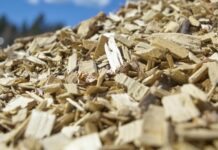The Baltic States, even though in case of those countries pellet consumption is insignificant, have increased the pellet production rates throughout the year 2015, becoming a major player, when it comes to exporting the resource to the EU member states.
Back in 2014, 35% of the wood pellet fuel exported to the EU member states was sourced from the Baltic states (20% from Lithuania, 10% from Estonia and 5% from Latvia). Total quantity of the pellet fuel manufactured globally was 27.1 million tonnes, around half of which (13.5 million tonnes) was manufactured in the EU. If one looked at pellet production in the Baltic region holistically, then we would see a quantity of 2.65 million tonnes, most of which was destined to be exported. If we add the Russian production, the quantity went up to 4.15 million tonnes. As it was summarized during the conference organized by the Wood Pellet Association of Canada in Halifax, back in 2015, it is easier for the Baltic states to deliver the resource to the nearby markets, and this is the decisive factor, within the scope of their competitiveness, as compared to the expansive North American market.
The growth forecast related to the pellet fuel market in Lithuania, Latvia and Estonia is optimistic, as the heating industry uses this resource within a larger scope, both in household heating, as well as at the local heat generating plants. Within the territory of Latvia, several new facilities are being established, with production capacity reaching up to 350 thousand tonnes of pellet per year. Estonia is about to increase its production by 150 thousand tonnes, in case of Lithuania, 30 thousand tonnes of growth is expected – as it was summed up by Ekman Group’s Arnold Dale during the Conference in Canada. Ekman Group is an international company operating in the forest sector.
Destined to be successful?
The Baltic states may compete against larger markets and markets with greater experience in the west, thanks to the richness of forests (more resources remaining at disposal of the manufacturers), low production costs (relatively), good access to ports, low cost of electricity and friendly law. So, what is the shape of the pellet fuel markets in the individual states?
Latvia began to expand its biofuels sector at the beginning of the 1990s, with assistance being provided by a Swedish company who made an investment and created the SBE Latvia Ltd. manufacturing facility. Now, the said facility produces around 600 tonnes of resource per year. The Latvian pellet fuel market was being expanded along with the sawmill market, and both sectors have seen a significant growth throughout the last decade. AS Graanul Invest company is one of the major players in Latvia, as it manages 11 pellet plants: 4 located in Estonia, 6 in Latvia and 1 in Lithuania. It is estimated that the said company is to manufacture 2.15 million tonnes of pellet fuel this year.
Considering the fact that the German German Pellets company is about to face bankruptcy, Graanul Invest is about to become the most important company manufacturing wooden pellet fuel in the European Union. As it has been stressed by the President of the Management Board of the Company, Raul Kirjanen, the success is not necessarily determined by the quantity of the manufactured material, as the main factor which contributed to the said success is seen in the wide array of the offered products, easiness of adapting to current trends and in the quality of after-sales support. Granuul Invest’s top brands include “Begreen”, “Naturkraft” and “Flex Heat”. More than 95% of the manufactured pellet quantity is being exported. The company also plans to establish a new manufacturing facility, in case of which production output of 250 tonnes of pellet fuel per year is expected. The two factories that are already operable are going to be expanded too. In a longer run, Kirjanen assumes that presence of the company’s products on the markets outside Europe is also to be increased.
Latvian Graanul Invest company, with all of its potential, is the largest European wooden pellet fuel manufacturer
Even though the export of the Latvian pellet fuel has been on the rise recently, the domestic consumption of the fuel remains at a level which is relatively low – around 100 thousand tonnes per year. The pellet fuel prices are dependent on the manufacturer, however, according to the Latvian LATbio Association of Biomass Manufacturers, one tonne of pellet fuel packed in 15 kg bags, with EN Plus A1 certificates, costs from EUR 130 to 140, while industrial pellet costs from EUR 115 to 124 per tonne.
The Estonian pellet fuel market has begun its existence around 20 years ago. Currently, the country, with 16 facilities operated, manufactures around 1 million tonnes of pellet fuel per annum, which means that annual growth is shaped at the level of around 300 thousand tonnes. Stora Enso and Purutuli companies are the most significant players on the market now. Similarly as it happens in case of Latvia, the Estonian manufacturers are driven towards exporting the pellet fuel to Denmark, Sweden, the UK and Italy. The domestic consumer is not a major customer, since local sales do not exceed around 50 thousand tonnes of pellet fuel yearly. Here, in case of supplies of pellet for the foreign customer, maritime transport plays the dominating role.
Lithuania manufactures the least significant quantity of pellet fuel, out of the Baltic group – only 350 thousand tonnes per year (data from 2014). Premium Pellet fuel, bagged, constitutes most of the aggregate produced. Most often, it is transported with trucks, and sent mainly to Germany, Denmark and Italy. The domestic consumption is limited to 30-50 thousand tonnes per year, however, the Lithuanian Litbioma association expects that using the biomass for the heat generation purposes is going to grow by several percent in the upcoming years.
Baltic Boom
It is estimated that the manufacturing facilities located within the territories of the three aforesaid countries, manufacture from 70 to 90 thousand tonnes of pellet per year, on average, with several outstanding entities, in case of which production capacity is much higher – up to 200 thousand tonnes per annum. The Baltic markets are fragmented, as numerous minor manufacturers are active, having a manufacturing potential of up to 10 thousand tonnes per year at their disposal. What is interesting, most of the manufacturers, pellet fuel exporters from the Baltic Sea region, have attained the EN Plus certificates (10 Latvian, 9 Lithuanian and 8 Estonian manufacturers). The manufacturers who are willing to expand their activities are also trying hard to obtain the SBP certificate, allowing them to supply the pellet fuel for the commercial power companies.
LATBio association expects that during the upcoming 10 years, 25 million tonnes of growth of pellet consumption may be expected, however this is dependent on the law, politics and weather conditions – all of these factors may have an impact on the pellet fuel consumption in every country. The existing organizations which gather together the biomass companies should be more active within their domestic markets, promoting the pellet fuel as a fuel which is environment-friendly and competitive, e.g. in comparison with coal. According to Arnold Dale, who is the Vice President at Ekman Group, consumption of pellet fuel within the domestic markets would be increased, following reductions of VAT rates applicable in case of these products (23% VAT in Poland, concerning the wood pellet fuel, is one of the highest rates in Europe) and after the limits within the feed-in tariff scheme, for the users of the biomass boilers, are increased.
LATBio estimates that in 10 years, in Latvia, consumption of wood shavings in industrial systems may grow up to the level of 6 million tonnes per year, while consumption of pellet fuel by the individual customers may reach the level of around 3 million tonnes yearly. In Lithuania, this proportion is to be shaped at the level of 5 million tonnes of shavings / 4 million tonnes of pellet, while corresponding ratio in Estonia, is expected to be characterized by the following quantities: 5 million tonnes of shavings and 2 million tonnes of pellet per year. These values are impressive, without any doubt, when one takes into account the population of the above listed states.
Poland Among the Leaders
In Poland, disproportion between export and consumption of the wood pellet is not so significant as in cases of Lithuania, Latvia and Estonia. The data provided by the Baltic Energy Conservation Agency, referring to the year 2014, mentions production shaped at the level of more than 800 thousand tonnes, out of which 400 thousand tonnes were destined to be exported (Germany, Italy, the United Kingdom, Sweden, Denmark). Around 280 thousand tonnes of pellet fuel were consumed at heat and power generating plants, while the remaining 200 thousand were used up by the remaining users, including households. Year by year, more and more manufacturers obtain the DIN Plus and EN Plus certificates, the possession of which is often an indispensable condition to introduce the product onto the markets abroad. All symptoms seem to suggest that production for the western customers, in the upcoming years, is going to grow, however the domestic consumption should also see a significant growth. Lack of stability of the fossil fuels market, governmental programs concerning the emissions, and finally, social awareness, will all contribute to growing popularity of wood pellet among the individual customers too. A decision to reduce the pellet-related VAT rate, down to the level of 10%, would change a lot. However, today, Poland, together with Lithuania, Latvia and Estonia, is becoming a part of the Baltic Pellet Boom.
JOLANTA KAMIŃSKA












































